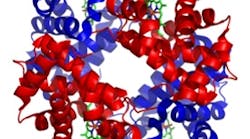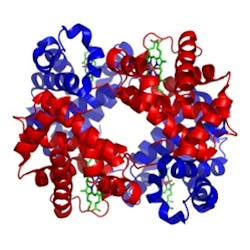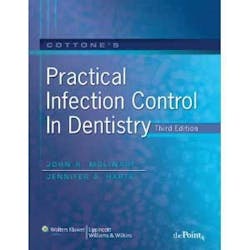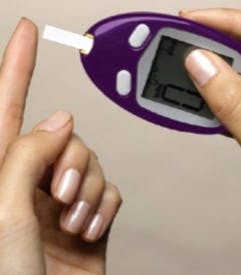By JoAnn R. Gurenlian, RDH, PhD
Diabetes is a worldwide epidemic affecting 285 million adults. By 2030, this number is estimated to increase to 439 million adults.(1) In the United States, diabetes affects almost 26 million individuals, and 79 million have pre-diabetes. Unfortunately, over 25 percent of individuals do not know they have the disease.(2) Diagnosing diabetes is accomplished through various blood testing procedures. Recently, focus has been on the use of the glycosylated hemoglobin or hemoglobin A1c assay for screening and diagnosis of diabetes.(3) A1c has been routinely used to monitor individuals with diabetes to determine their level of control.
Diabetes is a worldwide epidemic affecting 285 million adults. By 2030, this number is estimated to increase to 439 million adults.(1) In the United States, diabetes affects almost 26 million individuals, and 79 million have pre-diabetes. Unfortunately, over 25 percent of individuals do not know they have the disease.(2) Diagnosing diabetes is accomplished through various blood testing procedures. Recently, focus has been on the use of the glycosylated hemoglobin or hemoglobin A1c assay for screening and diagnosis of diabetes.(3) A1c has been routinely used to monitor individuals with diabetes to determine their level of control.
Hemoglobin is the predominant protein in red blood cells. Approximately 90 percent of hemoglobin is hemoglobin A. Hemoglobin A1c is a minor component of hemoglobin to which glucose is bound. The A1c test shows the average amount of glucose in blood over a period of 2-3 months, corresponding with the life span of red blood cells. The higher the A1c level, the higher the risk of developing complications of diabetes including diabetic retinopathy, blindness, cardiovascular disease and stroke, kidney damage leading to end stage renal disease, and nerve damage.(4)In his review of A1c and other glucose testing assays, Sacks(5) reported advantages of A1c for the diagnosis of diabetes. Some of these advantages included: no need for fasting, samples may be obtained any time of the day, very little biological variability, samples are not altered by acute factors such as stress or exercise, and is used to guide treatment. Some disadvantages of this study include the cost and finding may be altered by factors other than glucose, such as change in erythrocyte life span and ethnicity. In their recent publication concerning the role of the A1c test, the International Expert Committee recommended the use of A1c for the diagnosis of diabetes.(6) This position has been endorsed by the American Diabetes Association and the Endocrine Society.(5)Guidelines for A1c values are:• 5% = normal• 5.7% - 6.4% = prediabetes• 6.5% or > = diabetes• 7% or < = target control for diabetes• 8% = moderate control; medical intervention necessary• >10% = poor control
Currently, chairside/at-home tests are available for identifying A1c levels. Bayer A1Cnow Self-check and AccuBase A1C Test Kit are examples of A1c testing supplies that can be used conveniently. Samples can be collected by the oral health practitioner or patient, and laboratory results are mailed directly to the patient.
This testing capability may assist oral health care professionals in identifying those patients who are at risk for diabetes as well as those who have diabetes, but have yet to be diagnosed with the disease.References
1. Shaw JE, Sicree RA, Zimmet PZ. Global estimates of the prevalence of diabetes for 2010 and 2030. Diabetes Research and Clinical Practice. 2010;87(1):4-14. (www.ncbi.nlm.nih.gov/pubmed/19896746) 2. Centers for Disease Control and Prevention. National Diabetes Fact Sheet: national estimates and general information on diabetes and prediabetes in the United States, 2011. Atlanta, GA: U.S. Department of Health and Human Services, Centers for Disease Control and Prevention, 2011. (www.cdc.gov/diabetes/pubs/pdf/ndfs_2011.pdf) 3. Saudeck CD. Jer,am WJ. Sacls DB et al. A new look at screening and diagnosing diabetes mellitus. J Clin Endocrinol Metab 2008; 93:2447-2453.4. American Diabetes Association. Standards of medical care in diabetes-2011. Diabetes Care. 2011;Jan34 Suppl1:S11-61. (care.diabetesjournals.org/content/34/Supplement_1/S11.full.pdf+html) 5. Sacks DB. A1c versus glucose testing: a comparison. Diabetes Care. 2011;34(2). Available at www.medscape.com. Posted 3/2/11. Accessed 10/30/11. (care.diabetesjournals.org/content/34/2/518.extract) 6. International Expert Committee. International Expert Committee report on the role of the A1c assay in the diagnosis of diabetes. Diabetes Care 2009;32:1327-1334.
1. Shaw JE, Sicree RA, Zimmet PZ. Global estimates of the prevalence of diabetes for 2010 and 2030. Diabetes Research and Clinical Practice. 2010;87(1):4-14. (www.ncbi.nlm.nih.gov/pubmed/19896746) 2. Centers for Disease Control and Prevention. National Diabetes Fact Sheet: national estimates and general information on diabetes and prediabetes in the United States, 2011. Atlanta, GA: U.S. Department of Health and Human Services, Centers for Disease Control and Prevention, 2011. (www.cdc.gov/diabetes/pubs/pdf/ndfs_2011.pdf) 3. Saudeck CD. Jer,am WJ. Sacls DB et al. A new look at screening and diagnosing diabetes mellitus. J Clin Endocrinol Metab 2008; 93:2447-2453.4. American Diabetes Association. Standards of medical care in diabetes-2011. Diabetes Care. 2011;Jan34 Suppl1:S11-61. (care.diabetesjournals.org/content/34/Supplement_1/S11.full.pdf+html) 5. Sacks DB. A1c versus glucose testing: a comparison. Diabetes Care. 2011;34(2). Available at www.medscape.com. Posted 3/2/11. Accessed 10/30/11. (care.diabetesjournals.org/content/34/2/518.extract) 6. International Expert Committee. International Expert Committee report on the role of the A1c assay in the diagnosis of diabetes. Diabetes Care 2009;32:1327-1334.
JoAnn R. Gurenlian, RDH, PhD, is President, Gurenlian & Associates, and President-Elect, International Federation of Dental Hygienists.










